
Toilets as Modern and Contemporary Art: The Fluxus Movement
Toilets, Art and Fluxus
Fluxus is an international movement of artists who have been blending artistic media and disciplines in a Neo-Dada fashion since the 1960s, producing visual art and music in addition to influencing literature, design, and architecture and urban planning. The American composer and performer John Cage and the French artist Marcel Duchamp, both living in New York City in the 1950s, were major influences on the Fluxus movement. The Fluxus movement was formalized by the Lithuanian-born George Maciunas. Fluxus is Latin, meaning to flow, and as conceived by Maciunas it was anti-art and anti-commercial.
John Cage had composed experimental noise music through the 1950s, and in 1957–1959 he taught experimental composition courses exploring the concept of indeterminacy in art. A number of musicians and artists who attended these courses were later involved in Fluxus activities.
MarcelDuchamp
Meanwhile, Marcel Duchamp had been producing conceptual art since the early 1900s. By the time the cataclysm of the First World War engulfed Europe in 1914, Duchamp had come to dismiss the work of most artists of the time as purely "retinal", intended to please only the eye. Duchamp sought to make art that engaged the mind, instead of the pretty but uninteresting work being done by Matisse, Monet, and others. Impressionism and Post-Impressionism were innovations at the time, but Duchamp found them unfulfilling.
Duchamp's Nu descendant un escalier nº 2 or, as titled in English, Nude Descending a Staircase, No. 2, brought him to prominence in the art world. It's now considered a Modernist classic and is one of the most famous works of the period. But it was controversial at the time. The Cubists said it was too Futurist, partly because Cubism was a French movement leery of the influence of foreign groups like those largely Italian Futurists.
Despite the controversy, Duchamp managed to get his work displayed at the Exposició d'Art Cubista in Barcelona in the spring of 1912, and then it got much more exposure at the 1913 Armory Show in New York. This was the first American art exhibition displaying significant pieces from the European avant-garde including Fauvism, Cubism, Futurism, and more. American art theorists attending the show were scandalized as they were accustomed to nothing but Realism.
Duchamp'sReadymades
Duchamp's Readymades were what he called anti-art. The Readymades were ordinary manufactured objects which Duchamp selected and thereby defined to be art. He chose them based on his personal sense of irony, humor, and indifference. Duchamp's first "pure" Readymade was his 1914 Bottle Rack. His first toilet-themed Readymade was his 1917 Fontaine, executed 1917-1964 as the explanatory placard tells it. What really happened is that in 1917 Duchamp laid a urinal flat, signed it "R. Mutt", and called it an art piece. He continued with a series of these into the mid-1960s.
This artistic philosophy, generalized, came to be called Dadaism as it spread through Europe. Dadaism was a protest against what its adherents saw as the bourgeois nationalist and colonialist interests prevalent in Europe and leading to the World War. Dadaism involved visual art, literature and poetry, art theory, theatre, and graphic design. It was anti-bourgeois and leftist, and it included public gatherings, demonstrations, and publication of art and literary journals.
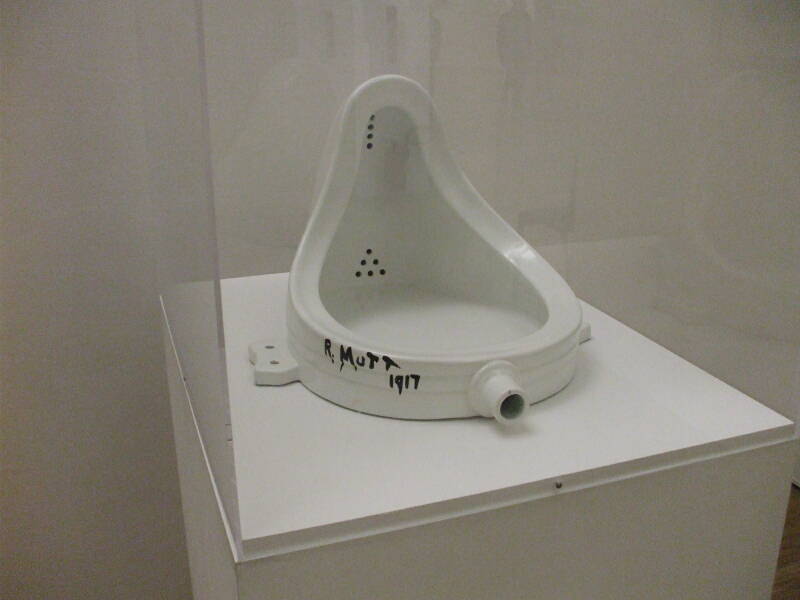
In 2004 Duchamp's Fontaine was selected as "the most influential artwork of the 20th century" by a group of 500 prominent artists and historians.
The original Fontaine piece was submitted to an exhibition but not accepted. The original was lost, apparently thrown out (which seems likely as it was something the artist had found discarded in the first place).
Then, starting in the 1950s, Duchamp was commissioned to make a number of replicas. They can now be found in a number of significant collections. One is at the Centre Pompidou in Paris, also known as Centre Beaubourg, one of the world's major museums of modern art. Other versions of Fontaine are in the collections of the San Francisco Museum of Modern Art, the Philadelphia Museum of Art, the Tate Modern in London, the National Gallery of Canada, and the Indiana University Art Museum.
On 4 January 2006, Pierre Pinoncelli, a French performance artist, attacked the version at the Centre Pompidou with a hammer.
Unlike the other "interventions", Pinoncelli used a hammer. The others, including South African artist Kendell Geers, Swedish artist Björn Kjelltoft, and Yuan Chai and Jian Jun Xi from China, used a more obvious and appropriate form of assault upon a urinal. As Chai said, "The urinal is there — it's an invitation. As Duchamp said himself, it's the artist's choice. He chooses what is art. We just added to it."
George Maciunas opened an art gallery on Madison Avenue in New York, and through that became involved with the avant-garde artists surrounding John Cage's late 1950s experimental composition courses. He first used the term Fluxus in promoting an art festival he organized in 1962 after moving to Germany for his job as a graphic designer for the U.S. Air Force.
Maciunas had originally referred to the philosophy as Neo-Dadaism or Renewed Dadaism. But Raoul Hausmann, an original member of the Dadaist movement, discouraged those terms.
Piano Activities, a performance work conceived by Philip Corner in 1962, has been re-created many times including in Roanoke, Virginia and, of course, Brooklyn, New York. The original "score", really just loose artistic suggestions, asked for any number of performers to "play", "pluck or tap", "scratch or rub", "drop objects on", "act on strings with", "strike soundboards, pins, lid or drag various kinds of objects across them", and "act in any way on underside of piano". The resulting Activities led to the complete destruction of a piano. Maciunas said:
"At the end we did Corner's Piano Activities not according to his instructions since we systematically destroyed a piano which I bought for $5 and had to have it all cut up to throw it away, otherwise we would have had to pay movers, a very practical composition, but German sentiments about the "instrument of Chopin" were hurt and they made a row about it..."
It's strange that the Germans got wound up that way, given that Chopin was actually Polish while Bach and Beethoven were German. They were so scandalized that the filmed destruction was shown four times on German television.
Foam City
The Foam City art group in Lafayette, Indiana channeled the modern Fluxus spirit. Their toilet was clearly designated as Fluxus Flush.
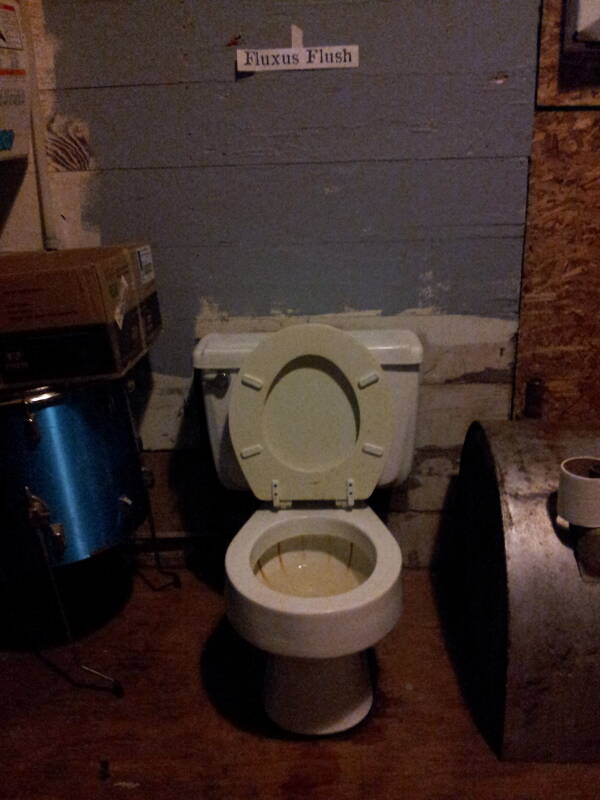
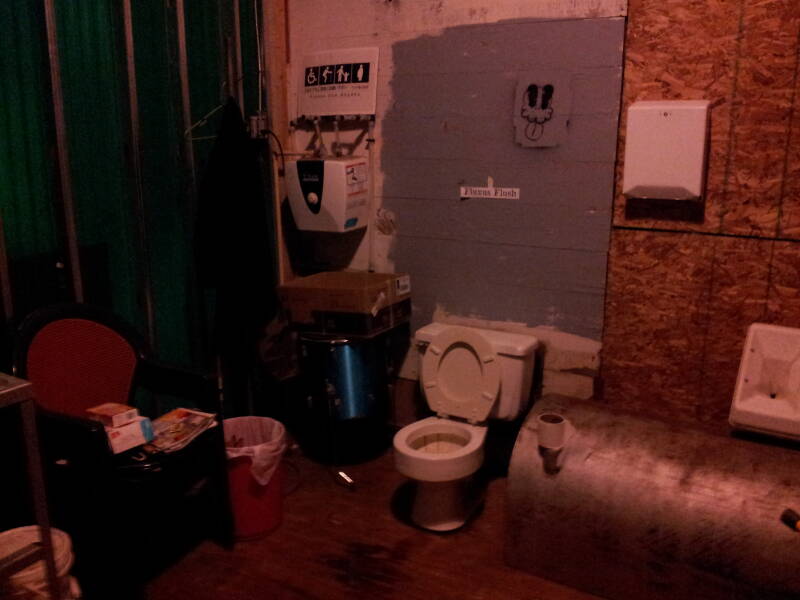
I submitted a number of audio tracks to Foam City's August, 2012 show Found Sound, including US STRATCOM Emergency Action Messages, over-the-horizon radar signals, Chinese numbers stations, and other aural ephemera.
Spot TavernAll that disappeared into the cacophony, what with the home-made instruments and two simultaneous sequencers (with IR-based theramins) plugged into guitar amplifiers. Xenia Rubinos was there, it was a legitimate art event.
Foam City has since closed. The Spot Tavern is the same owner's current venue for avant-garde Dadaist Fluxus events.
Sherrie Levine created her piece Fountain (After Marcel Duchamp) in 1991. It was exhibited at the Whitney Museum of American Art from November 10, 2011 through January 29, 2012 as a piece in her show Mayhem. This piece is cast bronze, 14.5×14×26 inches.
The New York Times carried a review of her show the day it opened.
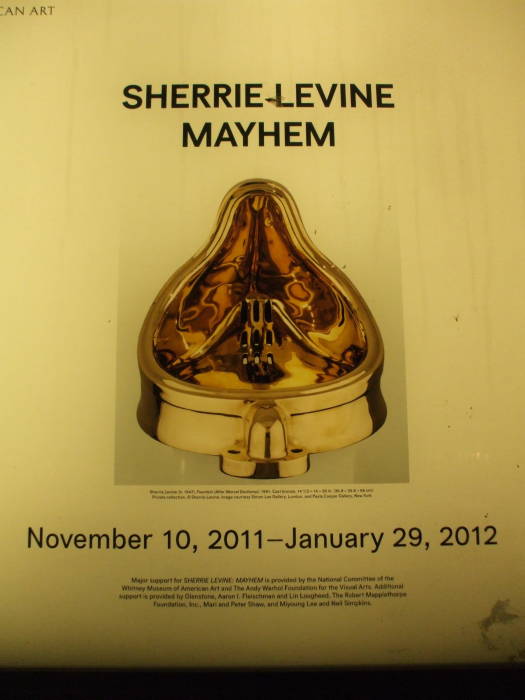
Another prominent Fluxus artist is A-yo, maker of the famous Fingerbox pieces.
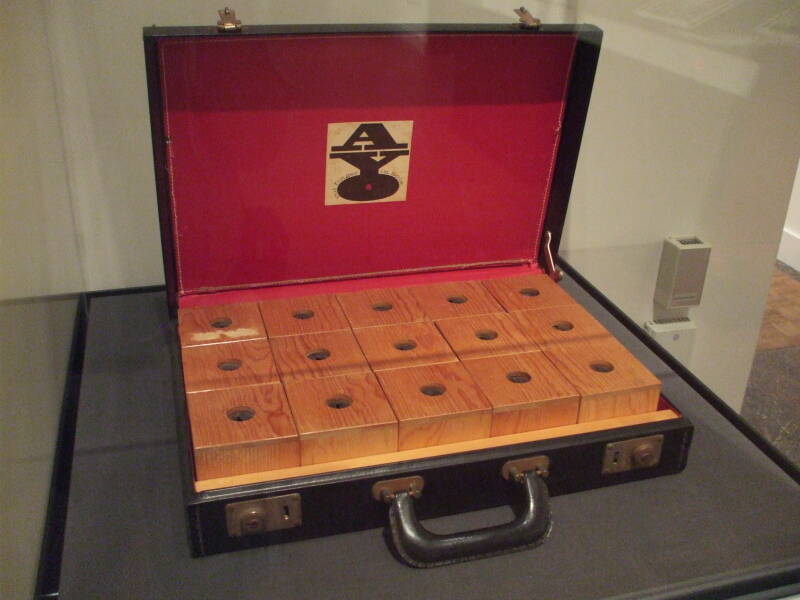
5x3 phased array fingerbox cluster.
America, the Golden Toilet
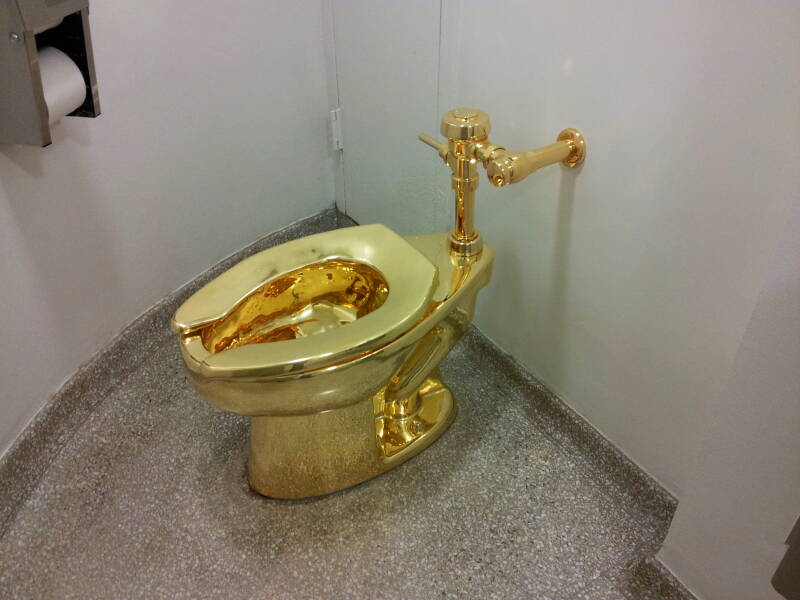
Maurizio Cattelan returned from retirement with a special project at the Guggenheim Museum in New York. His America (2016) replaced a toilet in one of the museum's public restrooms with a fully functional toilet cast in solid 18-carat gold. This was his first project since his 2011 retrospective at the Guggenheim and planned retirement. It opened in late September, 2016, with plans to remain there indefinitely. From the museum's description of this piece:
Cattelan's toilet offers a wink to the excesses of the art market, but also evokes the American dream of opportunity for all, its utility ultimately reminding us of the inescapable physical realities of our shared humanity.
It is an interactive piece, visitors are invited to interact with it "individually and privately". Guggenheim curator Nancy Spector wrote that America "closes the transgressive loop" that Duchamp started with his groundbreaking readymade. As you can see from the blue Sani-Flush border on these pictures, I closed the loop by interacting fully.
Spector said that "our sculpture conservator has done studies on the material and will be using a form of steam cleaning and special wipes. It will be kept clean throughout the day, as the Guggenheim does with all its bathrooms, but not steam cleaning necessarily."
A security officer stands outside the toilet, allowing people in one at a time. Bags must be left outside. The initial plan was for cleaning with a medical wipe every 15 minutes.
The museum shipped two toilets to Italy. Cattelan used those to cast multiple pieces which he cast in 18-carat gold and welded together. Michael Zall, the Associate Director of Operations at the Guggenheim, oversaw its installation by a professional plumber. The seat is not only quite cold, it is enormously heavy. And it only raises a few inches, so there is no risk of angering the next person in line by leaving the seat up.
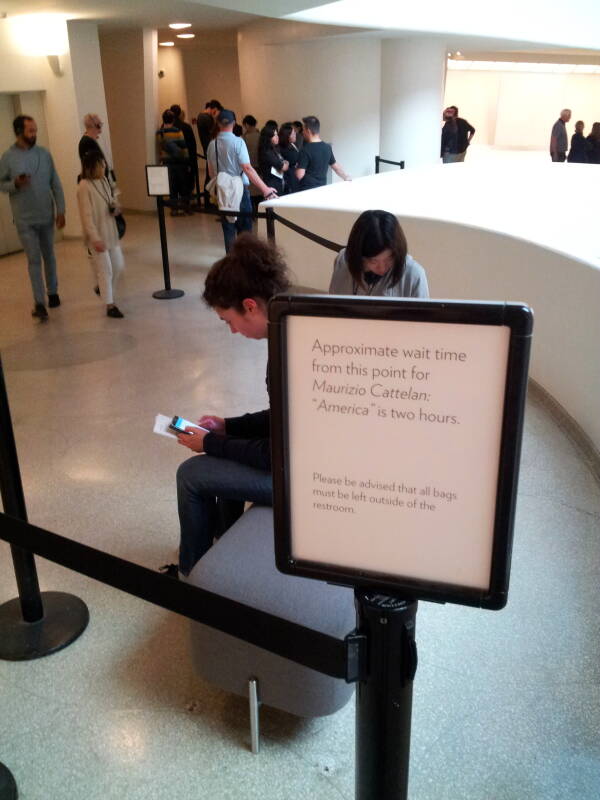
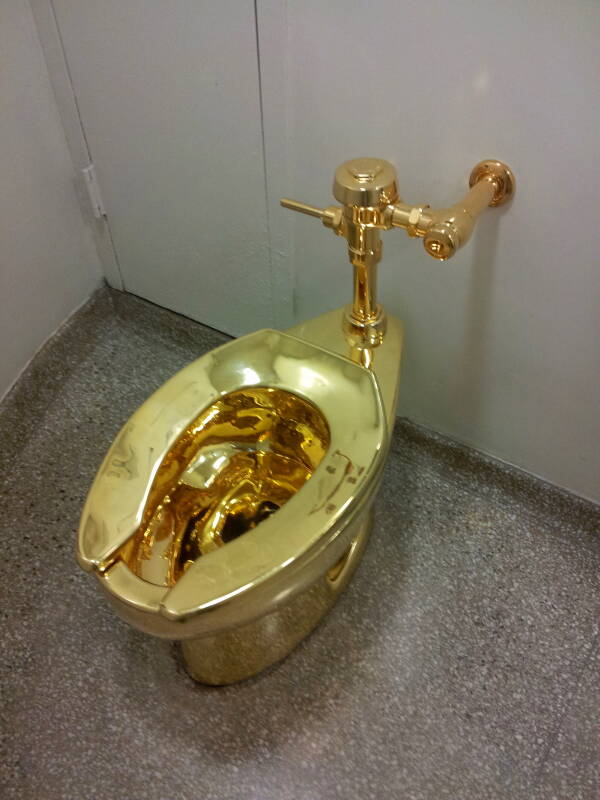
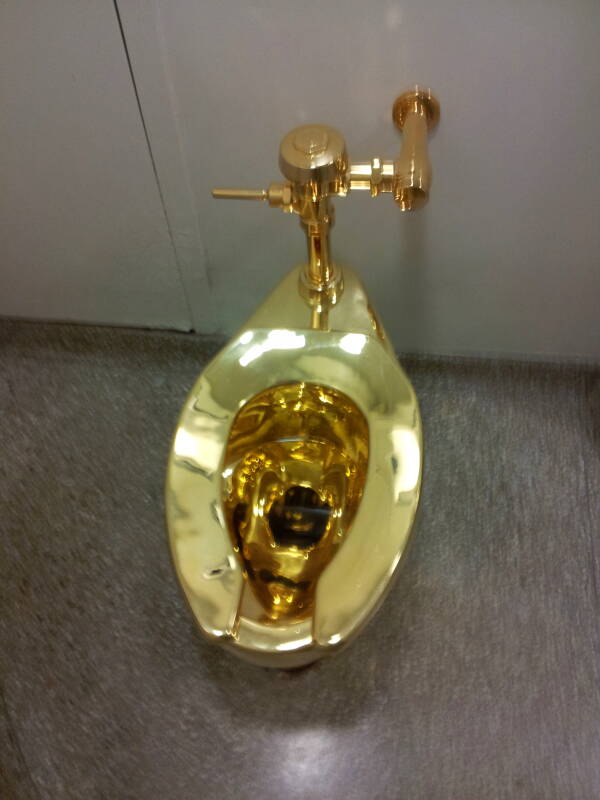
Media coverage of America: Guggenheim NPR New York Times, April 2016 New York Times, October 2016 The New Yorker ARTnews Fortune Wall Street Journal Guardian
I saw America on October 10, 2016, just a few weeks after it opened. This happened to be Columbus Day, in a year when there was increasing public outcry to rename it as "Indigenous Peoples' Day".
There was an "Intervention" that day! An anti-Columbus-Day activist put a "Decolonize This Place" sticker on the seat as reported on Hyperallergic.
I think the "intervention" occurred before I visited. I noticed that the security officer stepped into the restroom immediately after each visitor, before the next person was allowed to enter. Then again, it might have been sure to make sure that any solid waste had been flushed.
As for liquid waste, you can't easily tell if the water in the bowl of a gold toilet contains urine. Not unless there is something seriously wrong with your urine.
Frank Lloyd Wright designed the Guggenheim. This restroom on another floor shows how ridiculously impractical many of Wright's designs are. Unless your legs are rather short, this toilet is difficult to impossible to use.
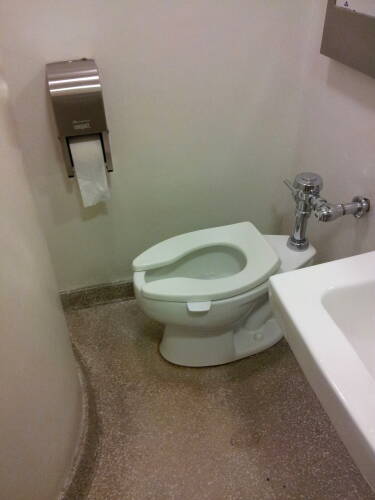

Then, in September 2017, a White House spokesperson wrote to the Guggenheim Museum, asking if Donald Trump and his third wife (so far) could borrow Landscape With Snow, a Vincent van Gogh painting, to decorate the Presidential residence.
Nancy Spector, the Guggenheim's chief curator, responded to Donna Hayashi Smith of the White House Office of the Curator. "I am sorry... to inform you that we are unable to participate in this loan since the painting is part of the museum's Thannhauser Collection, which is prohibited from travel except for the rarest of occasions,"
However, the America exhibit had just ended and the golden toilet was available "should the President and First Lady have any interest in installing it in the White House." Cattelan, the artist, had reported that he "would like to offer it to the White House for a long-term loan. It is, of course, extremely valuable and somewhat fragile, but we would provide all the instructions for its installation and care."
It seemed appropriate. Trump, after all, decorates his home and even his private airliner much like Saddam Hussein's palaces, including gold-plated bathroom fixtures.
Stories on this request and counter-offer,
and also describing Trump's Hussein-like taste
in decoration, include these from:
The Washington Post
The New York Times
The Hill
Time
BBC News
Forbes
Newsweek, Dec 2017
Newsweek, Jan 2018
Cattelan's golden toilet continued to make the news.
In September 2019 it was installed along with other artwork by Cattelan at Blemheim Palace in Oxfordshire, England, the birthplace of Winston Churchill.
Soon after it was installed, thieves stole it. Just as it had been when I experienced it, and used it, it was fully installed, plumbed in. And so, the theft led to a minor flood within the palace.
In November 2023 four men were charged with the theft. They were scheduled to appear in court on November 28, 2023.
Jim Dine
American pop artist Jim Dine is sometimes categorized as a member of the Neo-Dada movement. He started working with other artists and the musician John Cage in 1959. His works were exhibited along with those of Roy Lichtenstein, Andy Warhol, and others in 1962.
He created his Black Bathroom #2 in 1962. It is now in the collection of the Art Gallery of Ontario in Toronto. The nearby placard says:
Although Jim Dine incorporated everyday objects such as a bathroom sink in his work, he was always thinking about painting. Here Dine satirizes theories of how color is perceived: as a rule, black paint optically recedes while white paint juts forward. In this case, he playfully uses a water basin to show that white can literally spring out of a painting. To complicate matters, he creates the shadow of the sink's pipe using black paint to confuse our sense of what is real and what is art.
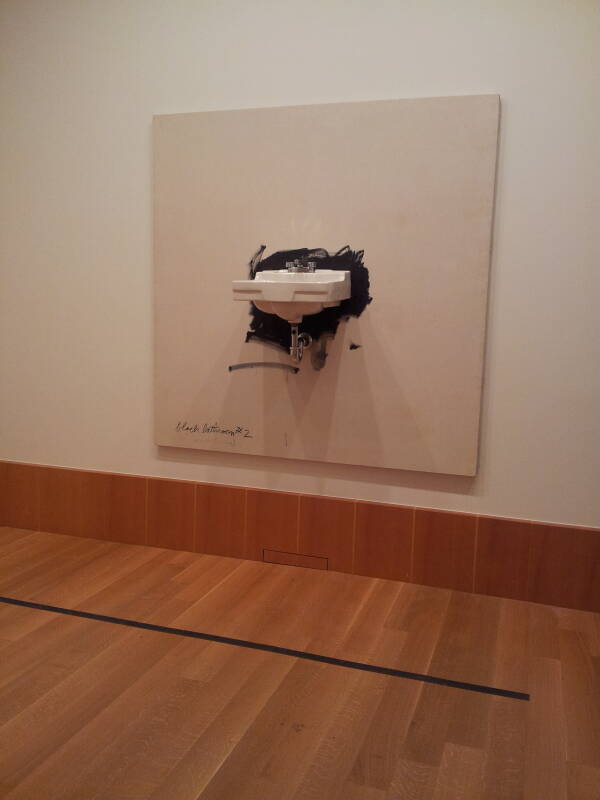
Merde d'Artiste
Piero Manzoni created a series of ninety objects in May 1961. Each is a can containing 30 grams of Manzoni's feces. The can lids are numbered 001 through 090. Each can is labeled in Italian, English, French, and German. The English label says:
| Artist's Shit |
|
Contents 30 gr net freshly preserved, produced and tinned in May 1961. |
If you're wondering, the French (seen here), Italian, and German terms are Merde d'Artiste, Merda d'Artista, and Künstlerscheisse, respectively.
This example is at the Museum of Modern Art in New York.
We're not sure exactly how many cans Manzoni sold during his lifetime, but a receipt dated 23 August 1962 certifies that Alberto Lùcia traded 30 grams of 18-carat gold for one. Art theorists say that when Manzoni priced his excrement as gold, that referenced a tradition of artist as alchemist that was established by Duchamp and others. Artist and critic Jon Thompson wrote in Piero Manzoni, 1998, page 45:
Manzoni's critical and metaphorical reification of the artist's body, its processes and products, pointed the way towards an understanding of the persona of the artist and the product of the artist's body as a consumable object. The Merda d'artista, the artist's shit, dried naturally and canned "with no added preservatives", was the perfect metaphor for the bodied and disembodied nature of artistic labour: the work of art as fully incorporated raw material, and its violent expulsion as commodity. Manzoni understood the creative act as part of the cycle of consumption: as a constant reprocessing, packaging, marketing, consuming, reprocessing, packaging, ad infinitum.
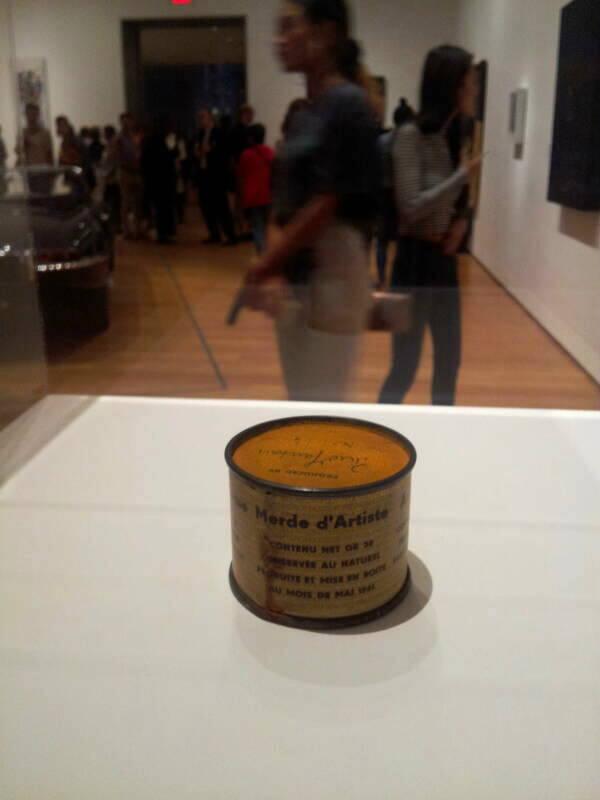
Andy Warhol's Urine Paintings
Andy Warhol created his Oxidations series in the mid-to-late 1970s. This one is in the Baltimore Museum of Art. The nearby placard explains:
ANDY WARHOL
American, 1928 — 1987
Oxidation Painting
1978
Acrylic paint containing metallic pigment
with portions oxidized by urine.
The abstract works that Warhol produced late in his career were a radical departure for an artist who, up until the mid-1970s, had been strongly associated with pictures of recognizable products and personalities. To create the Oxidations series, Warhol, his assistants, and visitors to his studio urinated on canvases prepared with metallic paints, causing color variation through a chemical reaction. The resulting images, which tread the line between vulgarity and beauty, are characteristic of the ambiguity Warhol cultivated around his work. They also raise the question of whether the process by which an artwork is made has an influence on its meaning and impact.
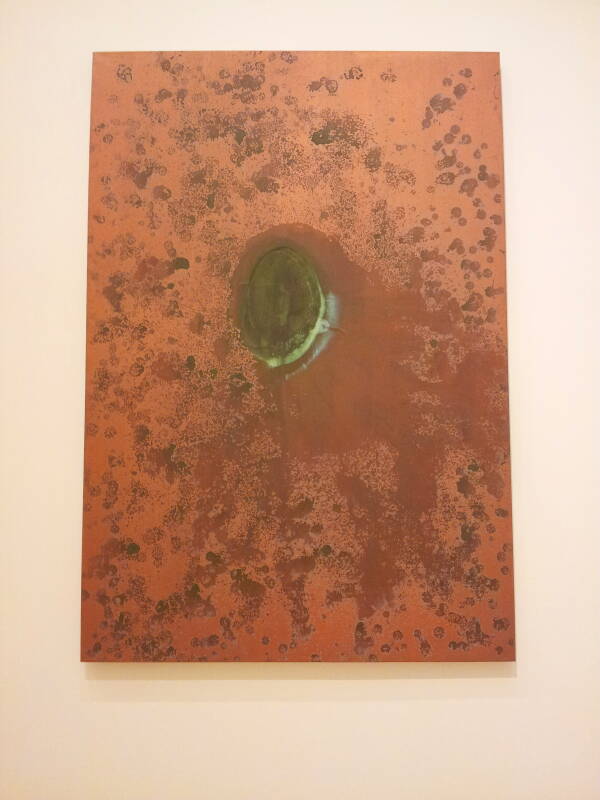
in New York
The Revelation special exhibit at the Brooklyn Museum in 2022 focused on Andy's spiritual side, with his baptismal certificate and several of his works with religious themes including his large series of works based on da Vinci's Last Supper.
It also included a photo of Andy with three other contemporary artists, crowded into Andy's bathroom:
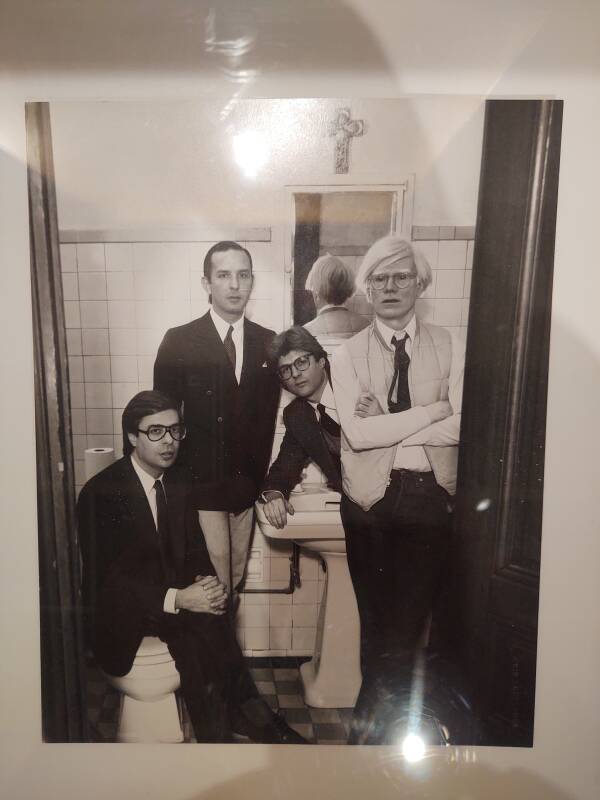
Naoshima Art Houses
VisitingNaoshima
The island of Naoshima in Japan's Seto Inland Sea was once reliant on fishing and harvesting seaweed. Heavy pollution hurt both of those. There were few opportunities for young people, who moved away. Naoshima and surrounding islands were turning into retirement settlements with rapidly aging and shrinking populations.
In the early 1990s a multi-island art project began with the Benesse Art Site established by the Benesse Corporation. The Setouchi Triennale contemporary art festival began in 2010. Abandoned buildings became art installations.
Visitors usually arrive at Miyanoura Port, on a ferry from Honshū, Japan's largest island, or Takamatsu on Shikoku, the fourth largest. Walk across the island from Miyanoura to Honmura, it's just two kilometers. You will find the Art House Project.
Below is the Haisha House. It used to be a dentist's home and office. Now a space has been opened through both floors and the attic, housing a Statue of Liberty replica, and other rooms have been turned into individual art installations. Including a bathroom.
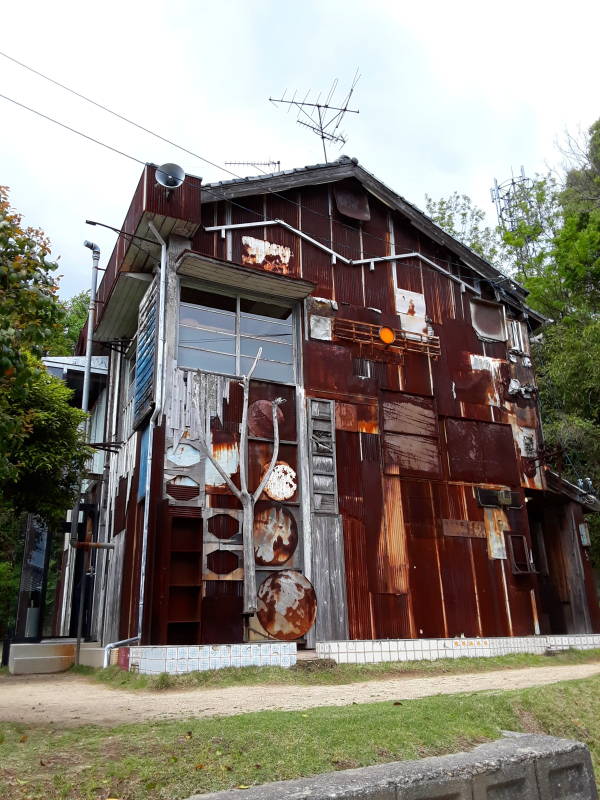
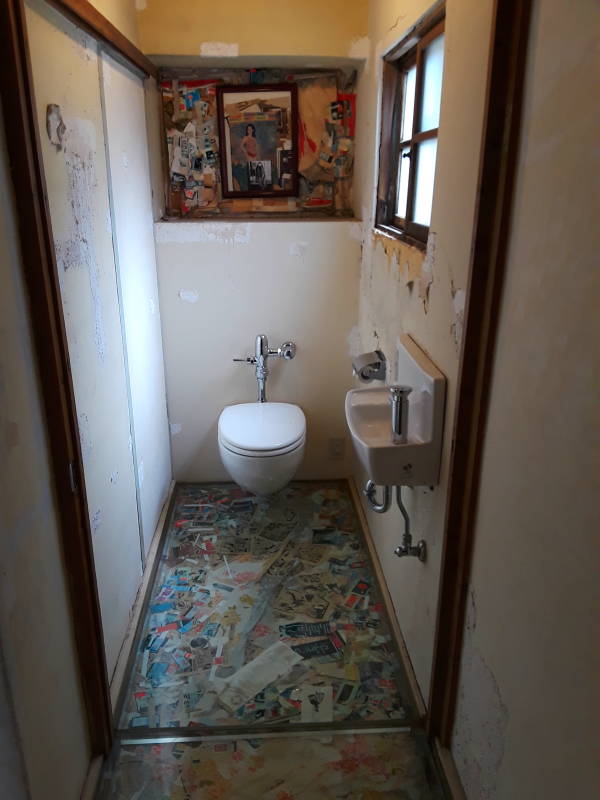
Clorindo Testa
Clorindo Testa was an Italian-Argentine architect and artist. He was born in Benevento, Italy, and then graduated from the School of Architecture at the Universidad de Buenos Aires in 1948. He was a leader of the Argentine Rationalist movement and a pioneer of the Brutalist movement in Argentina.
In 1952, he participated in a government study that sought to apply Modernist urban planning to the working-class Avellaneda District in Buenos Aires. The CIAM or Congrès Internationaux d'Architecture Moderne had devised the "Athens Charter" in 1933. This was a functionalist code for city planning, which divided a district into the four basic functions of living, transportation, work, and recreation. The 1952 study applied the Athens Charter to Buenos Aires.
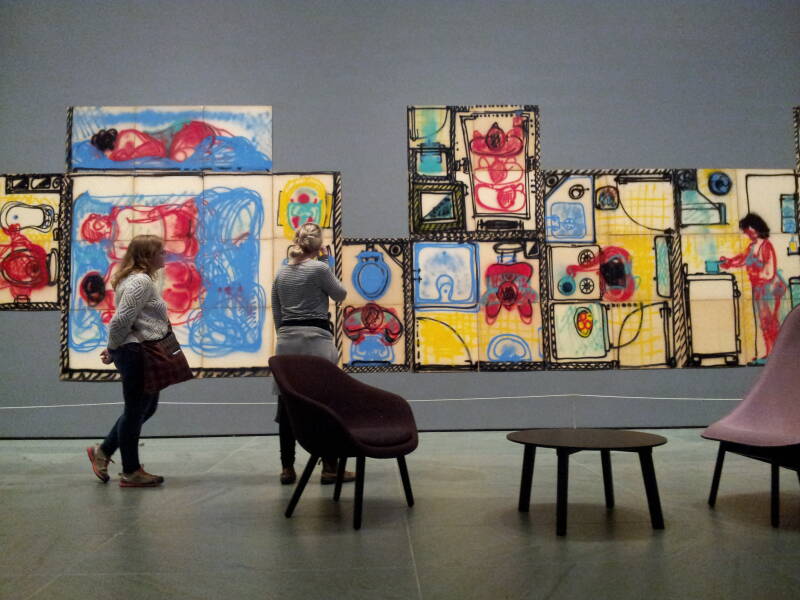
Testa painted these panels documenting the conditions found in that study, and the conditions in the same area in the early 1970s. The panels are now in the collection of the Museum of Modern Art in New York, They depict toilets, bidets, sinks, and showers within homes.
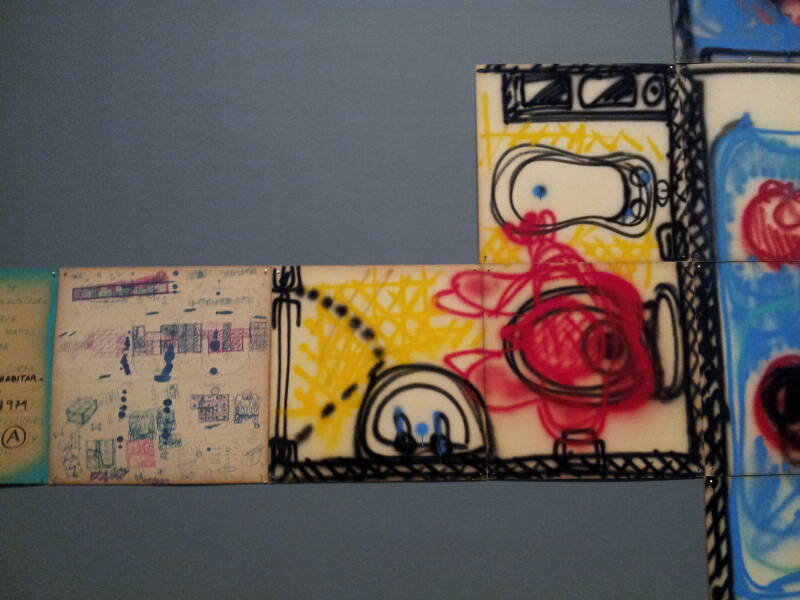
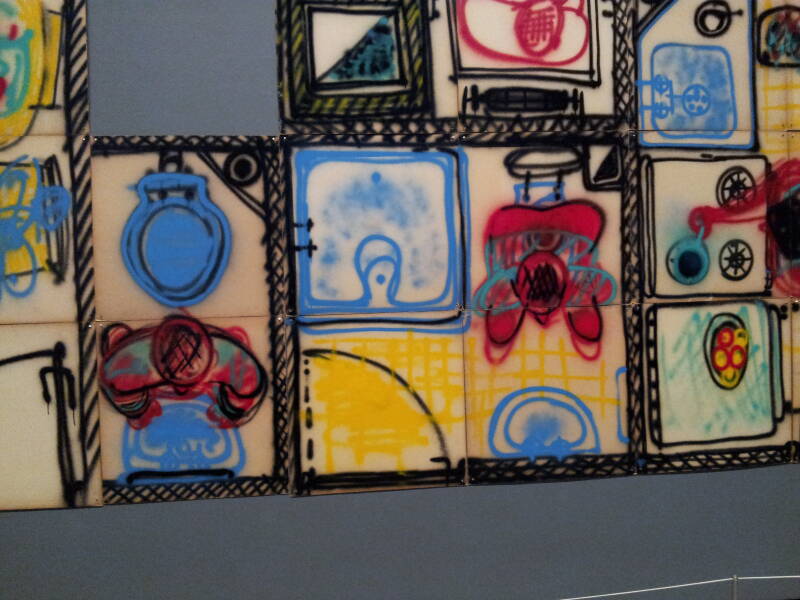
The description provided by the museum includes:
Broad, gestural strokes, referencing street art or graffiti, combine plan and elevation views in nearly life-size images that follow the sequence of his day: at rest, rising to bathe and eat, commuting aboard a crowded bus, returning home in the evening to his living room and television. These spaces are compact and oppressive, illustrating how the problems that the Athens Charter sought to eradicate, and potentially aggravated, remained in place in the contemporary city. The commanding scale of the mural coupled with the intimate portrait of ordinary life powerfully critique modernism's functional city, while the juxtaposition of presentation styles highlights Testa's background as both an architect and a painter.
Charlotte Perriand's Savoie
The second piece of toilet-themed art at Centre Pompidou in Paris seems to me to have much more intentional thinking and design. Not that there's anything wrong with a lack of all that.
Charlotte Perriand (1903-1999), designed and built the sanitary block Savoie in 1972-1974. It's a modular bathroom with tub and shower, sink, and toilet, built of polyester reinforced with fibreglass.
The unit is included in the museum's section on industrial design.
The intent of the design was to support economical and efficient construction while providing pleasant living conditions.
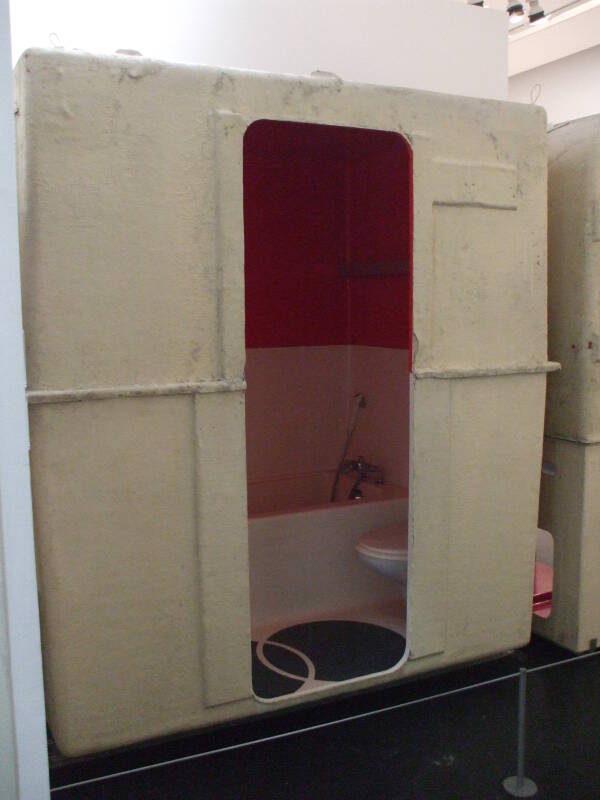
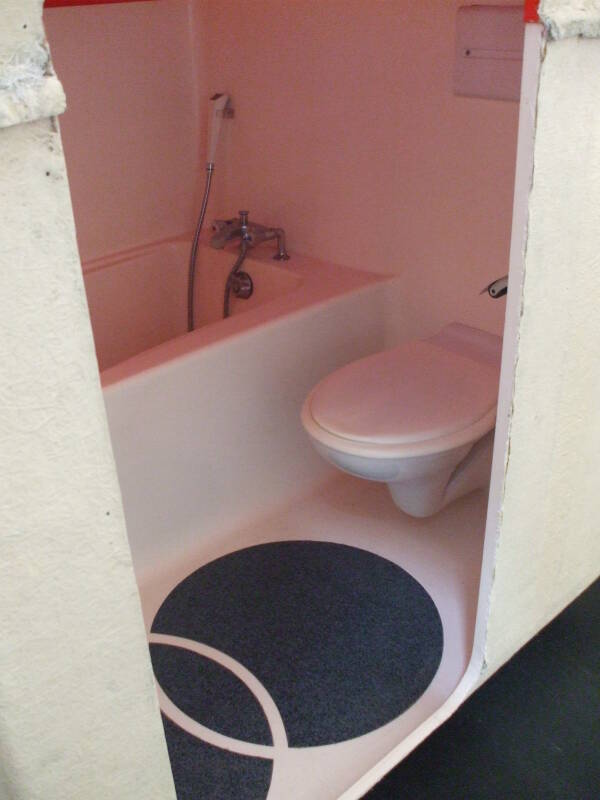
Several years later I saw another copy of Perriand's Savoie quite a bit closer to my home, at the Art Institute in Chicago in their Architecture and Design collection.
It was better lit and there was no lid in the way, so I was able to see that it actually has a bidet rather than a toilet.
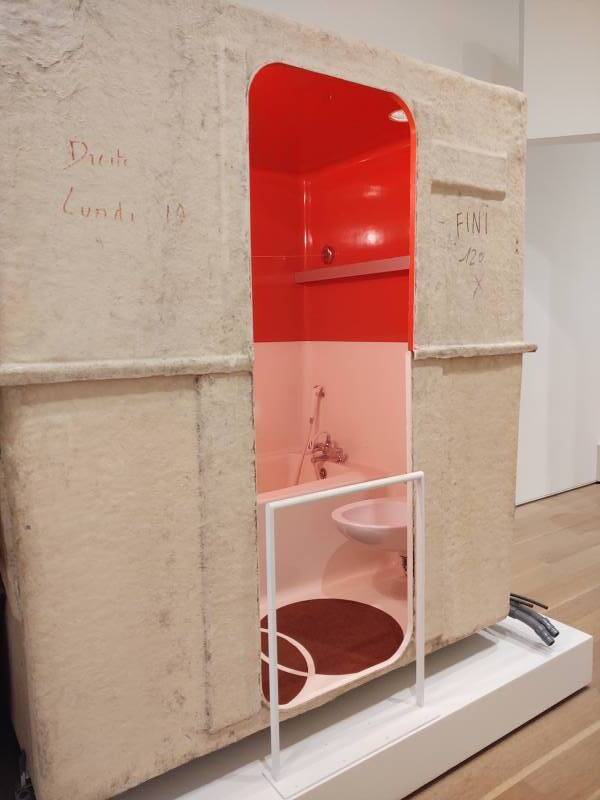
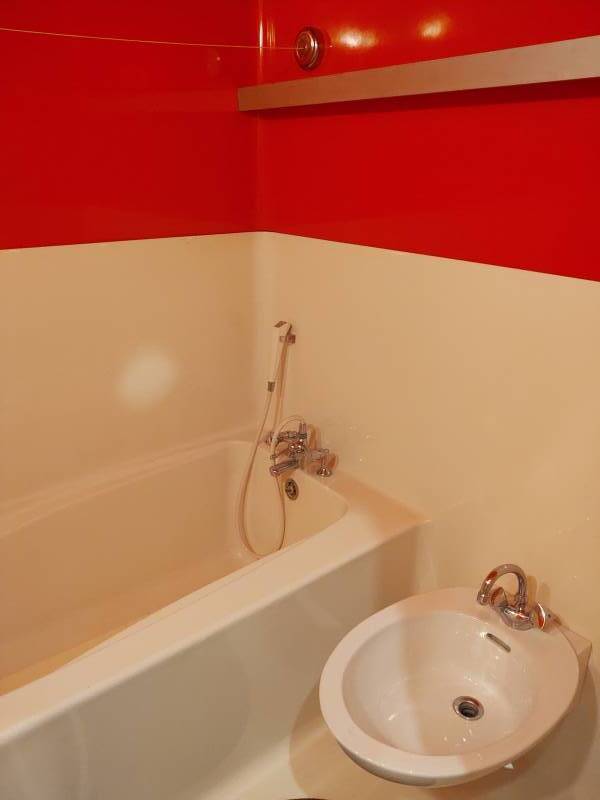
The nearby card explained:
Leisure and the Prefab
After decades of designing furniture and new technologies for the home, pioneering architect Charlotte Perriand joined a team in the 1960s and '70s working to create a sky resort at Les Arcs, one of the largest projects of her career.
The Les Arcs development was intended to democratize access to alpine leisure in France through low-cost construction and prefabicated elements. One of Perriand's most important contributions was a novel design for kitchens and bathrooms that allowed the units to be produced off-site and "plugged" into the building structure. Perriand married the glossy, high-tech finishes of these fiberglass units with white walls, rustic pine furnishings, and large windows, bringing views of the mountains into the many small apartments of the complex.
Perriand's passion for the Alps helped shape a new vision for living in and enjoying the mountains in Les Arcs. The development's modern bujildings responded to the landscape and ushered in a new age of winter recreation in France.
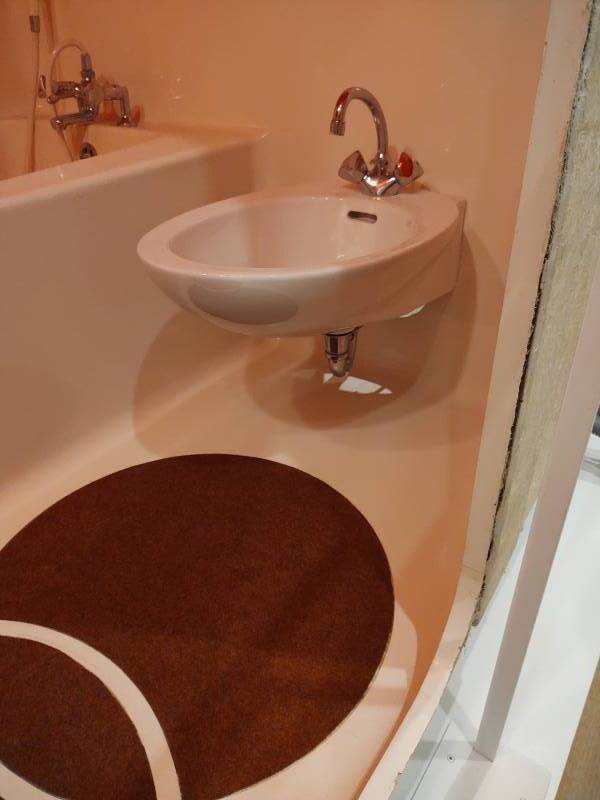
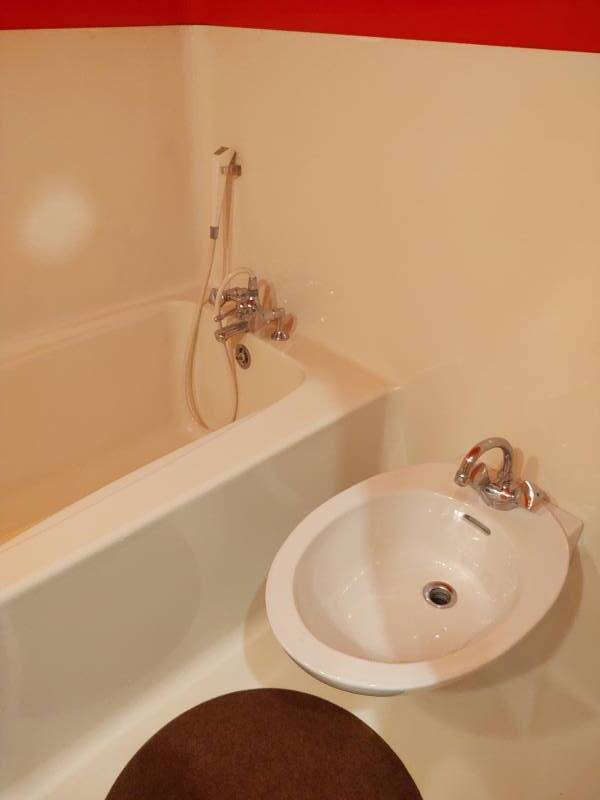
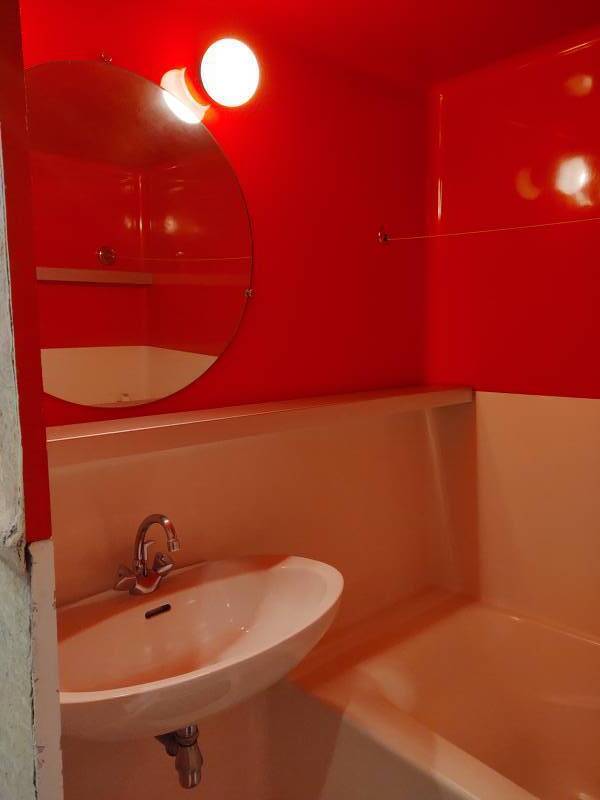
The above is described as:
Charlotte Perriand
French, 1903–1999
Prefabricated Bath Unit, Les Tournavelles,
Arc 1800, France
1975/78
Polyester and fiberglass shell, monoblock polyester,
ceramic, and chrome-plated brass
Gift of Jerzy and Nina Sobota, 2014.1179
The below is described as:
Charlotte Perriand
French, 1903–1999
Prefabricated Kitchen Unit, Les Tournavelles,
Arc 1800, France
1975/78
Polyester and fiberglass shell with unoxidized steel
Funds provided by the Architecture & Design Society,
2014.1175
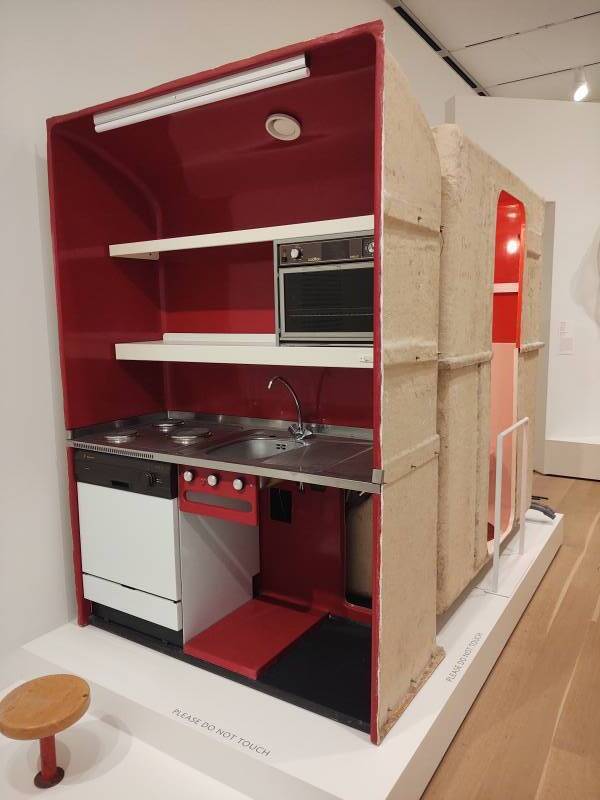
The idea of prefabrication has long fascinated architects and designers. Kitchens and bathrooms became special focuses for study due to the many different materials and trades required to produce them. Charlotte Perriand's prefabs at the Les Arcs ski resort—molded fiberglass shells in unexpected blue, green, and red—represent one of the rare projecgts of this kind that achieved large-scale production, with thousands of units created over the course of a decade. Complete at the end of Perriand's career, these units were the culmination of many years of work to make domestic spaces more usable, affordable, responsive to contemporary life, and, especially at Les Arcs, enjoyable and fun.
The exterior of the end of the bath unit is ready to be connected.
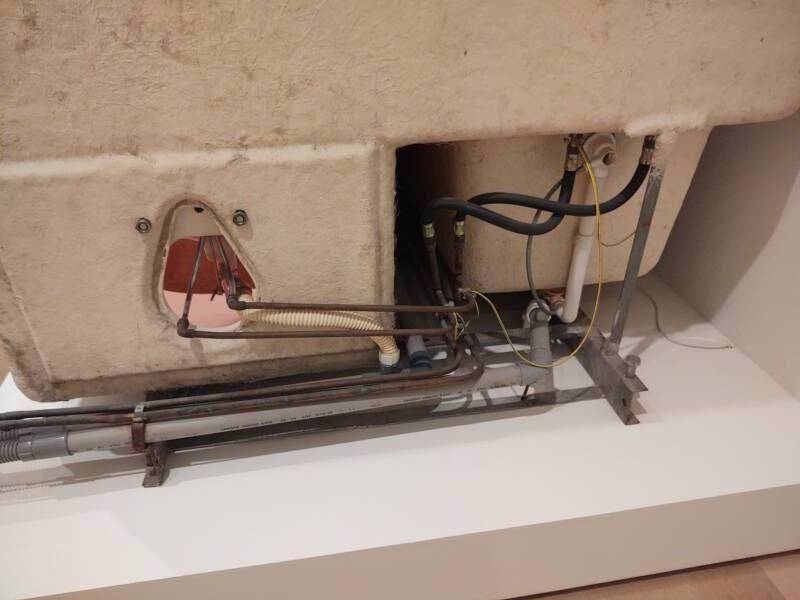
And now, moving from the Art Institute's Architecture and Design collection to their Contemporary Art collection...
R. Buckminster Fuller's Prefabricated Bathroom
The architect, systems theorist, designer, and futurist R. Buckminster Fuller was working on modular prefabricated bathroom modules much earlier.
Fuller's U.S. Patent 2,220,482 was filed 12 May 1938, and issued or awarded 5 Nov 1940.

Double Sink, Robert Gober
The Art Institute of Chicago Contemporary Art collection includes Double Sink (1984) by Robert Gober. It's made of latex and enamel on plaster, wood, wire lath, and steel.
He studied literature and then fine art at Middlebury College in Vermont, and the Tyler School of Art in Rome. He moved to New York in 1974 and initially worked as a carpenter, and worked as an assistant to the painter Elizabeth Murray.
He started painting, but in the 1980s he moved to sculpture, making pieces related to familiar domestic objects such as sinks and doors.
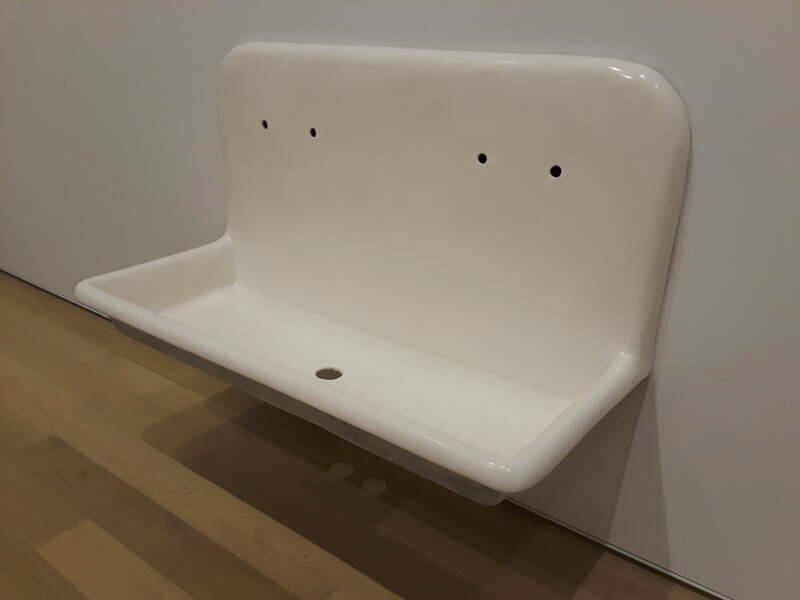
Great Alaska Outhouse Experience, Craig Buchanan
Central Alaska, Fairbanks, and UAFThis is the Great Alaska Outhouse Experience (2005) by Craig N. Buchanan. He made it from found materials and historical objects. You can open the doors and step inside.
I saw it, experienced it really, in the Museum of the Arctic on the campus of the University of Alaska Fairbanks.
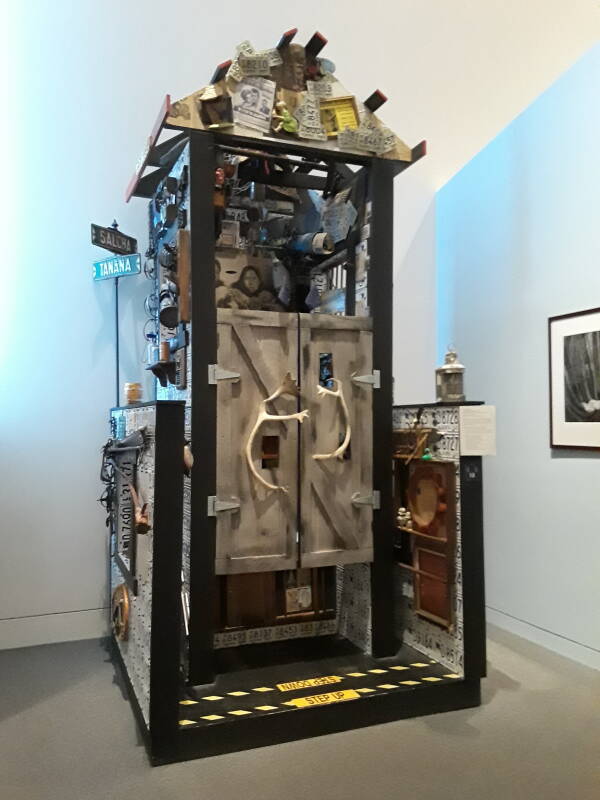
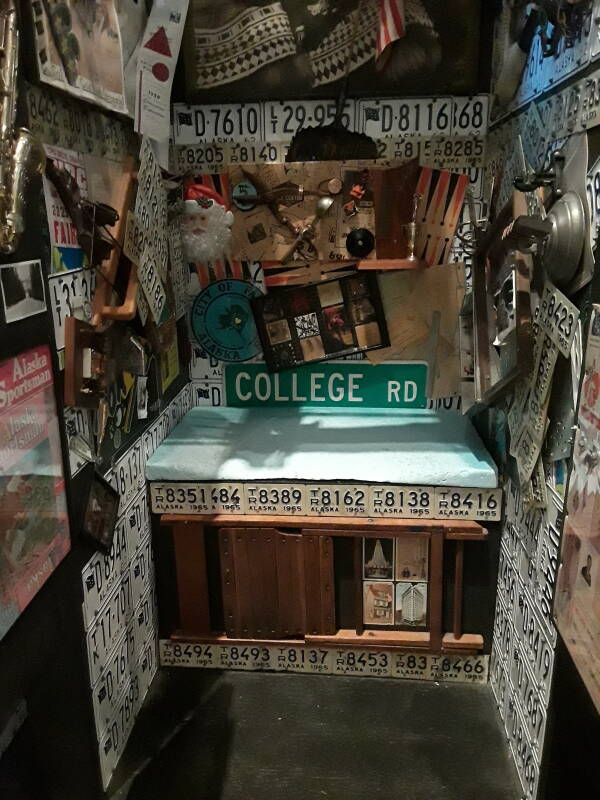
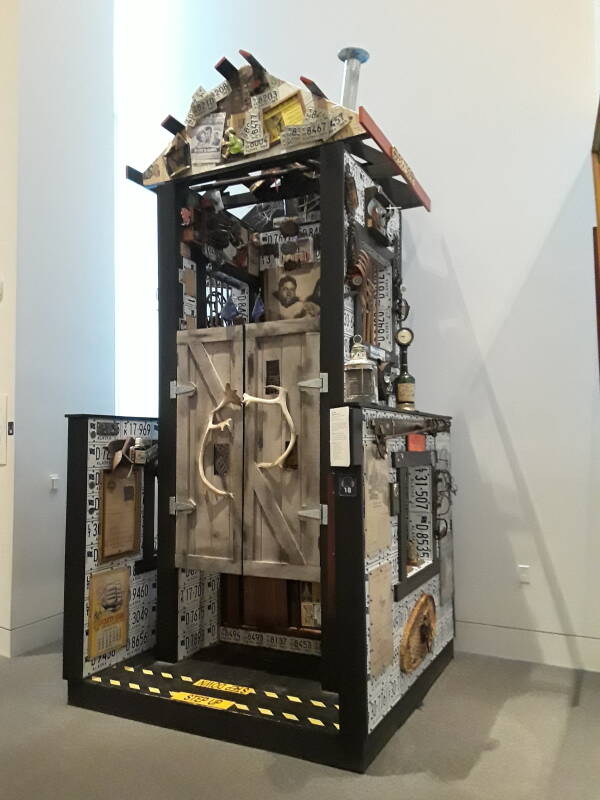
Upside Down World, David Henry Nobody, Jr.
The artist David Henry Nobody Jr created Upside Down World as a site-specific installation of an inverted room, accompanied by a series of performance art videos. Accompanied, of course, by NFTs or Non-Fungible Tokens, receipts containing cryptographic evidence that you paid a certain amount for the receipt. In this case, 0.1 Ethereum or about US$ 121 at the time. While anyone can view and probably download the art piece without paying.
This work clearly references the early 1980s Inverted Christmas immersive installation at 1240 Fowler Courts at Purdue University.
As the accompanying description for this derivative work of 2022 says:
The set is meant to be the living quarters of a cybernetic butler avatar in a burned out mansion. Each video is an imaginary tableau of the character's subconscious nightmares and fantasies reflecting a time of massive geo-political challenges. The wheel represents the hectic movements of the cycle of life as humanity is being tumbled into unknown territories. These inverted realities become a conversation on collective illusions in society.
Art gallery writing is its own form of performance art.
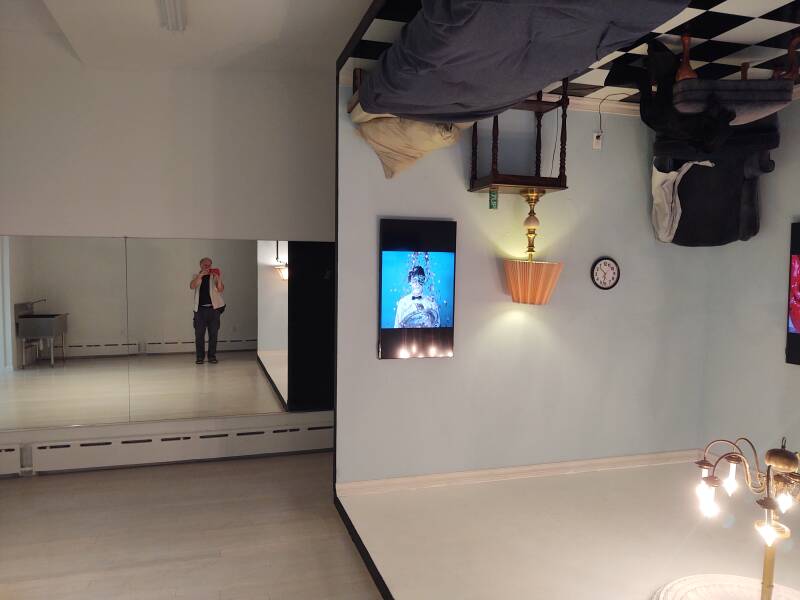
The public was invited to participate, inserting themselves
into the work to take selfies and then
post them
with the tag
#upsidedownnobody.
So I did. If I'm going to post this as @ToiletGuru, I had better be sure to include some plumbing in the frame.